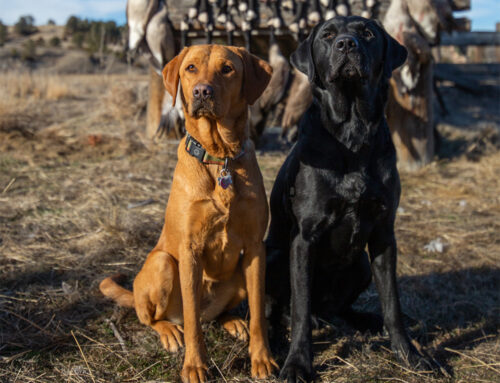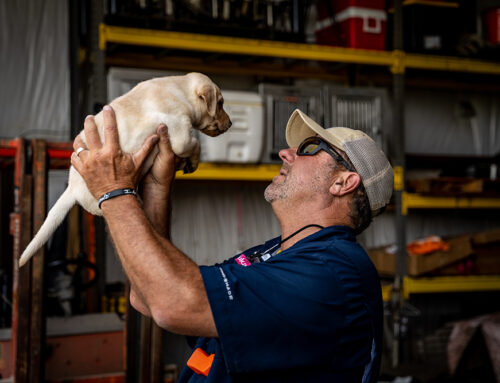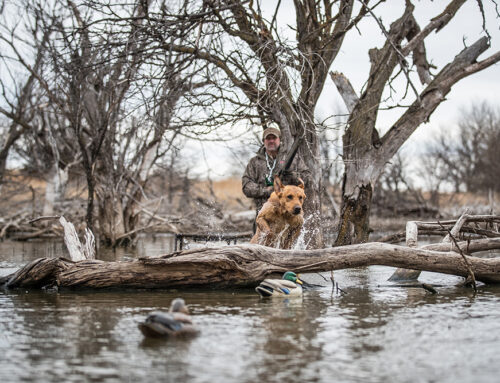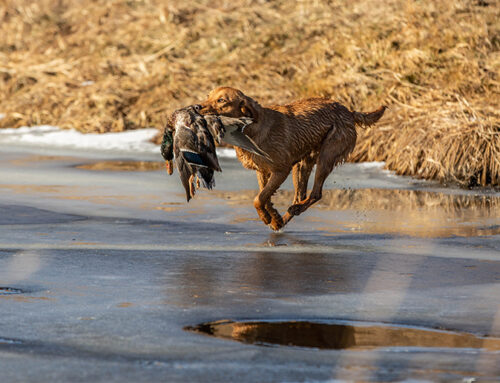Winterize Your Retriever

Ben Peterson/Delta Waterfowl
Careful preparation and optimum nutrition help dogs withstand the late-season chill
By Kyle Wintersteen
The air temperature hovered in the 20s, Russell Kelley recalls of a fateful morning decades ago, and wind gusts stung the faces of six teenage duck-hunting buddies.
“It was cold, especially for kids growing up in Alabama,” said Kelley, now science lead/service and working dog research manager for Eukanuba. “I had a really nice black Lab male, and he had such a great day that it still comes up when I get together with those guys. He retrieved for all of us, everybody limited out and we lost no birds. One duck was sort of winged down 300 to 400 yards away, and after about 15 minutes, my dog emerged with it.”
The late season is a wonderful time to make such memories while pursuing beautifully plumed ducks concentrated by diminishing open water. But extreme cold and wintery conditions also pose hazards for duck dogs, ranging from discomfort to malnourishment and hypothermia. Avoid these perils with pre-season preparation and in-season care to ensure your dog remains happy and performing well.
Promote a Thick, Oily Coat
In addition to their retrieving skills, there’s a crucial reason Chessies and Labs are such popular duck dogs: Their thick, oily coats are a water-resistant barrier against the elements that allows them to hunt in all but the worst conditions.
“Anyone who’s owned a retriever, particularly a black Lab, knows that when the coat is healthy and oily, it shines and almost looks glossy,” Kelley said. “Those natural oils help the dog shed water and dry out more quickly relative to other breeds, lowering the effect of cold air on their bodies. That keeps them comfortable and allows them to work longer, because they’re spending less energy on staying warm. Another advantage is less water ends up back in the boat.”
There are several keys to ensuring a retriever’s coat is as thick and oily as possible.
Back in the era when “dad’s hunting dog” always lived outside, a Lab’s coat thickened in response to shortening daylight hours (not plummeting temperatures). Yet these days, most gundogs live inside as part of the family and might not sense the changing seasons. The solution lies in limiting your dog’s exposure to artificial light — in other words, keeping a dark home after dusk — starting in August. Doing so will promote an undercoat of similar density to an outdoor dog’s while decreasing your electric bill.
August is also the time to stop bathing your retriever, lest you remove precious oils from its skin and coat. If necessary, bathe your dog in cool water, but avoid soap. Your spouse will get over it.
With an oily, fully developed coat in place, all that’s left is a proper-fitting neoprene vest to maximally safeguard your pup.
Fight Cold with Calories
Skin and coat health are further promoted by an optimum diet that includes high protein and fat content. That’s among the reasons it’s important to feed a quality performance formula, such as Eukanuba Premium Performance 30/20, so your dog’s fat and protein stores are sufficient as the rigors of hunting are exacerbated by exposure to frigid conditions.
“Adequate lipids (fats) are a primary requirement for skin and coat health,” Kelley said. “They’re also a primary energy source.”
Given that your dog’s energy and skin/coat needs draw from similar reserves, its health and happiness might suffer if it’s fed a standard dog food (typically less than 30 percent protein and 20 percent fat) or an inadequate amount of an energy-rich performance formula.
“One of the first things you’ll see with a lipid deficiency in retrievers is a duller coat and possibly increased dandruff,” Kelley advised. “That hampers them in multiple ways, including their water-resistance and warmth.”
That spells trouble: The dog’s already insufficient energy stores can be further stressed as arctic chills penetrate its weakened coat. So don’t let your pup reach that point.
“If you’re hunting dry fields, the temperature is close to zero and you’ve hunted for a long period of time, consider doubling your dog’s food for that day,” Kelley said. “If we’re talking exposure to cold water or wind, the energy requirements are further increased. Unless you hunt again, you can resume feeding a normal portion the next day.”
Adequate cold-weather feeding is an inexact science that requires judgement on your part. How brutal were the conditions? How many retrieves did your dog make? How long was it exposed to water? Was it well rested the day before? Monitor your dog’s body score (whether it’s at an ideal weight) and adjust food quantity accordingly throughout the season.
“You really have to pay attention to a dog that’s hunting frequently in cold climates, because the thinner they get, the more challenge they’re going to have in retaining heat,” Kelley explained. “You also don’t want an overweight dog, so it’s a constant challenge. It’s important to put your hands on the dog at least once per week to ensure it has a thin layer of fat on its ribs.”
Groom for Winter
You can further prepare your retriever for frosty weather with routine grooming. For instance, when dogs run across a snow-covered stubble field, the powder can lodge in their pads and compact into ice. It’s aggravating to remove, uncomfortable for the dog and poses a mild injury risk. So, if snow is in your hunt forecast, carefully use scissors or a small electric clipper to trim the hair around your dog’s pads, ensuring none protrudes to the ground. Trimmed paws are far less prone to accumulating snow and ice.
It’s also important to inspect your dog’s toenail length about every two weeks. It seems reasonable that long nails would provide added traction in snow and ice. In reality, they actually decrease grip and cause the pads to open as the dog runs, trapping snow.
Watch for Warning Signs
With these precautions, Labs and Chessies are well suited to fairly severe cold. However, it’s still smart to monitor for signs of discomfort and pre-hypothermia, particularly if you own a less cold-tolerant breed such as a spaniel. Watch out for uncontrollable shivering, confusion, command refusals or a dog that curls up in an attempt to warm itself. These are all indications it’s time to call it a day.
Don’t worry, there will be more ducks. And when they arrive, your winterized retriever will be ready for them.
Kyle Wintersteen of Bellefonte, Pennsylvania, is managing editor of Delta Waterfowl.






Leave A Comment